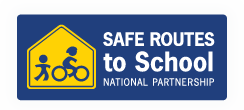So you're staring out your window, watching cars race by your local street corner, and suddenly it hits you: "We need a marked crosswalk there!" You grab your phone and as your fingers aim towards the dial pad something else hits you: "I have no idea who to call about this."
For a lot of would-be pedestrian advocates the journey to a crosswalk ends right there because, and I say this as someone who works in one, nobody in their right mind wants to wade into the swamps of a murky local government bureaucracy voluntarily. You might never get out.
Seriously.
I occasionally turn the corner at work and run across some lost soul who just wanted to renew their food handlers permit back in 1983 and has been at the civic center ever since.
But it doesn't have to be that hard--or at least, that confusing. To help you out in your endeavours, I've put together this handy guide to help you turn your favorite crossing from plain pavement to pedestrian paradise. (One caveat before we begin: I've tried to keep this as generic as possible, but since every city/state/country's government is organized a little differently, I can't guarantee I've covered all potential scenarios. Hopefully this will at least give you a starting point.)
Step 1: Why are we doing this again?
If you're serious about getting a crosswalk installed in your neighborhood, you need a convincing argument for installing it--and by convincing I don't mean generic or self-serving complaints like "people in my neighborhood drive too fast" or "I hate having to walk an extra block to cross the street." These may be legitimate problems, but remember that yours is only one of hundreds of similar requests your city receives. To make yours rise to the top you need to:
For a lot of would-be pedestrian advocates the journey to a crosswalk ends right there because, and I say this as someone who works in one, nobody in their right mind wants to wade into the swamps of a murky local government bureaucracy voluntarily. You might never get out.
Seriously.
I occasionally turn the corner at work and run across some lost soul who just wanted to renew their food handlers permit back in 1983 and has been at the civic center ever since.
But it doesn't have to be that hard--or at least, that confusing. To help you out in your endeavours, I've put together this handy guide to help you turn your favorite crossing from plain pavement to pedestrian paradise. (One caveat before we begin: I've tried to keep this as generic as possible, but since every city/state/country's government is organized a little differently, I can't guarantee I've covered all potential scenarios. Hopefully this will at least give you a starting point.)
Photo courtesy of Streetsblog
Step 1: Why are we doing this again?
If you're serious about getting a crosswalk installed in your neighborhood, you need a convincing argument for installing it--and by convincing I don't mean generic or self-serving complaints like "people in my neighborhood drive too fast" or "I hate having to walk an extra block to cross the street." These may be legitimate problems, but remember that yours is only one of hundreds of similar requests your city receives. To make yours rise to the top you need to:
- Be polite - This can be a frustrating process, but rudeness gets you nowhere but the trash can. Letters to your city beginning "Dear pea-brains" does not further your cause (plus they get boring after a while). Along these same lines, ranting letters in ALL CAPS do not endear you to the folks whose help you need.
- Be sane - Now is not the time to bring up conspiracy theories, aliens, or explicit pictures. Ditto on the chicken/bloody corpse/traffic light costume
- Get data - Can you spend an hour counting how many people try to cross the road on a typical afternoon? Calculate how many schoolchildren use the crossing to get home? Find out the number of past crashes at your location? The more detailed information you have to demonstrate that there is a problem at your crossing, the stronger your argument becomes
- Gather support - From your neighbors, your PTA, your local pedestrian advocacy organization (more on this in Step 7)








